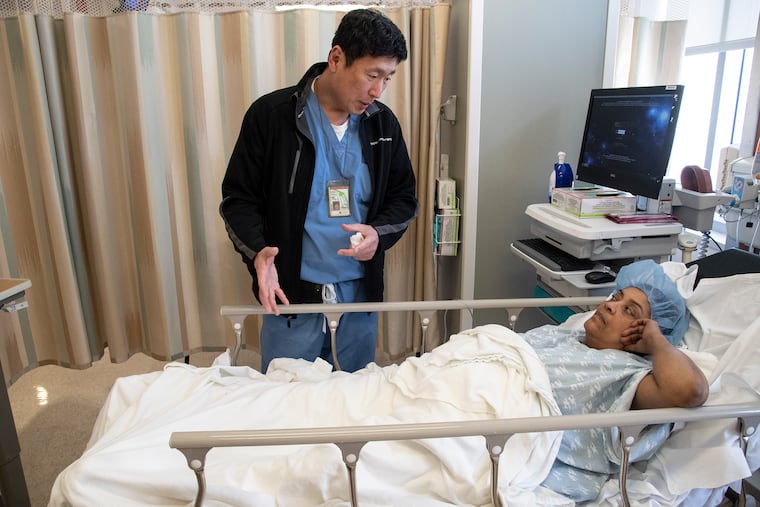With techniques used to save the heart, surgeons are rescuing limbs from the ravages of diabetes
Good medical care, including surgery, can help diabetics with serious vascular problems keep their feet and legs.

In a Temple University Hospital operating room, vascular surgeon Eric Choi and his seven-member team gathered to try to save Carmen Suero’s left pinky toe. Swollen and black with gangrene, it was dying from lack of blood circulation, a potential victim of the diabetes that had already led to five heart attacks and open heart surgery.
Suero, just 55, had come to the Temple Limb Salvage Center, which Choi directs, for the first time five days earlier. Choi hoped to restore better blood flow to her foot using techniques similar to those often employed to forestall heart damage. His immediate goal was to save the toe, but, in the long term, unblocking an important artery in Suero’s leg might prevent or delay even bigger amputations.
Like other vascular surgeons in the region, Choi has promoted speeding up care for patients like Suero. Minimizing disability can help them stay active. Even the loss of a little toe — usually it’s the big toe that goes first — can affect balance, and exercise helps control blood sugar.
Choi hoped that day in April to avoid having to transfer part of one of Suero’s veins to the damaged artery in her left leg — the lower-extremity equivalent of a heart bypass. Less invasive methods of opening arteries that use tiny wires, balloons, stents, and medications have made leg bypasses less common than they used to be.
"We don't want to do a big operation," he said, "because we don't want to hurt the heart." He warned her he would have to bring her back another day for a bypass if he found more damage than he could fix with balloons and stents.
‘Try not to get it’
Suero, who grew up in the Dominican Republic and has been in the United States for 27 years, waited serenely before surgery even though her leg ached from poor circulation. Through an interpreter, she said in Spanish that she was not worried because she had already been through so much heart trouble.
Her mother had had diabetes and Suero learned that she had it, too, in 2007. On disability since her heart surgery in 2011, she lived with her two sons. Her 19-year-old has dystonia, a muscle disorder that has left him unable to walk or talk.
She said she had tried to take her medications properly and eat a healthy diet. She blamed stress and "suffering" for her medical problems and said she lost control of her diabetes after her mother died in January.
Before her gurney was pushed to the OR, she shared one piece of advice: “If you don’t have diabetes, try not to get it.”
The X-ray was stunning
Choi’s first step was to study the blood vessels in Suero’s leg with X-ray and ultrasound. The important thing about Suero’s X-ray was not what it showed, but what it didn’t. The left superficial femoral artery was missing from the picture, a sign that it was completely blocked. A few smaller vessels had grown to fill the void, but not enough to get sufficient blood to Suero’s foot. It looked as if the blockage had been there for years, Choi said.
He threaded a tiny needle through Suero’s right femoral artery, up toward her belly button and then down into the left femoral artery. The wire it pulled would serve as a guide for a small catheter and another wire that would act like a train track for the other engineering wonders that would travel into the blocked vessel, a branch of the femoral artery about a fifth of an inch in diameter. With the catheter and wire, Choi poked his way through the gunk, a collection of plaque he said was rubbery with a hard surface, a bit like an M&M stuffed with a Tootsie Roll. Once he bored a tunnel, he used a tiny balloon inflated with water to push the artery open.
The before and after X-rays were stunning. Gradually, a new highway in Suero’s leg appeared, moving downward toward her foot. But there was a problem. The vessel walls were tough and stiff. They would not stay open on their own. Choi would have to try a stent, a tubular, basket-like device that can prop blood vessels open.
He picked one that was about six inches long and a quarter inch in diameter. It was compressed within two sheaths as it rode along the guide wire. When it was in the right place, Choi freed it with another wire. The vessel was so hard that he also had to push the stent open with another balloon. That worked, but the new blood flow revealed two narrow spots in the vessel farther down Suero’s leg. Luckily, Choi was able to open those blockages with a balloon. It’s not good to have multiple stents in one leg.
In about an hour, Choi had improved the flow enough that he could feel a pulse in Suero's foot, which hadn't had a pulse for years. She would feel better as soon as she woke up.
But this was not a cure, Choi said. Normal blood vessels are supple and muscular. They expand when the heart sends blood through them and then contract to keep it flowing. Suero's hardened arteries would not recover their healthy vigor. Her blood flow would be better, but not normal.
Suero is now doing well, Choi said this month. She’d cut back on smoking and was walking well. Her toe looks and feels better, but there was still a chance she might lose the tip.